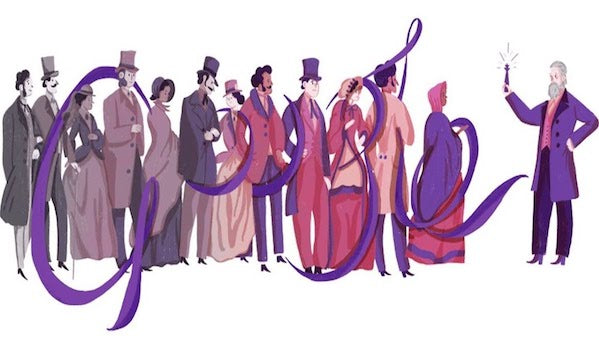
Mauve Mania
If you're already reading this online, it's likely that you will have seen today's Google Doodle, featuring none other than William Perkin; the man who discovered purple dye. As today marks what would have been Perkin's birthday, we look back to Selvedge issue 45, when Sarah Jane Downing got to the bottom of 'mauve mania'...

When artificial purple arrived in the 19th century it was a fashion revolution – but it all happened by accident. 18 year-old William Perkin was experimenting in his makeshift chemistry lab at home. One of the youngest students to be accepted into the Royal College of Chemistry, he was delighted by chemistry and utterly inspired by his charismatic professor, August Wilhelm von Hofmann. Perkin’s intention was to synthesise quinine, a holiday assignment set by Hofmann: but instead of the lifesaving treatment for malaria, all Perkin had managed to produce was a beaker of black sludge. As he was rinsing the beaker with alcohol he found that the liquid turned an interesting shade of mauve and his curiosity was piqued.

Knowing that his professor would disapprove, he turned to his friend and co-pupil Arthur Church to help in his experiments to create a purple dye. There was a schism across the class divide between ‘legitimate’ scientists and those willing to use their discoveries in industry, and there was a significant risk that if Perkin failed on the ‘trade’ side of the equation his scientific career would be over before it even began.

Wary, yet determined to make the most of his strange finding, Perkin contacted dye manufacturers. He received an encouraging reply from Robert Pullar in Perth: ‘if your discovery doesn’t make the goods too expensive, it is decidedly one of the most valuable that has come out for a very long time.’ Perkin took out a patent in August 1856.

With admirable faith in his son, Perkin senior – a successful builder and developer – provided the funding and started building work on a site next to the Black Horse pub on banks of the Grand Union canal in Greenford London. It wasn’t long before brother Thomas Dix Perkin gave up his architecture course to help, making it a family firm. The business quickly became profitable, not least because the coal tar from which the colour derived was an ever abundant waste product from many branches of industry...

You can read this article in full in Selvedge issue 45.
